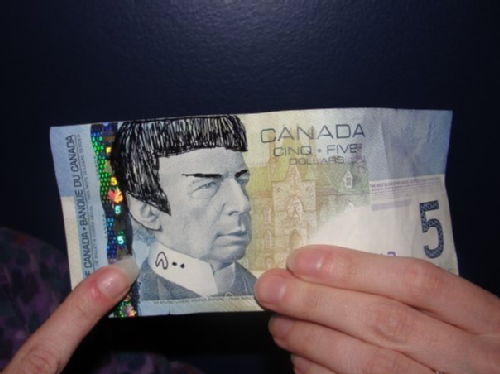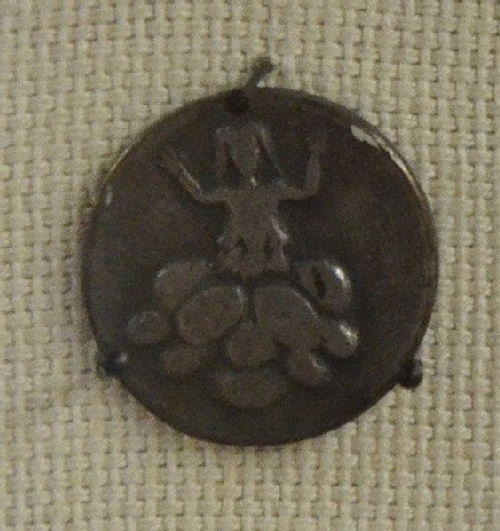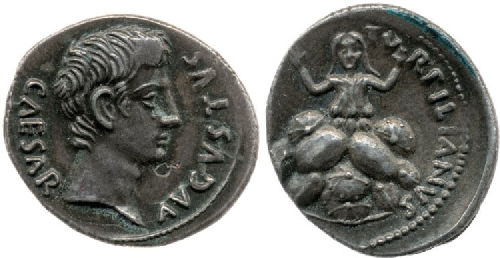All 1 entries tagged Verulamium
No other Warwick Blogs use the tag Verulamium on entries | View entries tagged Verulamium at Technorati | There are no images tagged Verulamium on this blog
March 04, 2015
Spocking Fives and a Mithraic token. Currency defacement ancient and modern.
 |
|
A Canadian $5 note that has been 'Spocked'
|
The death of Leonard Nimoy last week has sparked an upsurge in the Canadian practice of 'spocking' their $5 notes, using a pen or other implement to transform the portrait of their former Prime Minister, Wilfrid Laurier, into the famous Star Trek character. The particular style of the Prime Minister's portait, its large size, as well as the colour of the note (the same colour as Spock's uniform), serve to encourage this tradition (which has at least two active Facebook groups). While the alteration or defacement of currency is a crime in many societies, it is not strictly illegal in Canada, although the bank of Canada has stated that 'writing and markings on bank notes are inappropriate as they are a symbol of our country and a source of national pride'. Alterations to currencies often occur in the context of rebellion or dissatisfaction with the ruling power; defacement for fun or to honour someone is rarer.
 |
| Coin altered into a token |
Ancient parallels for the practice do exist, however. During excavations of a Roman building in St. Albans in Britain (ancient Verulamium), an object (shown left) was found under Building IV (the floor dated to the second century AD). It was a silver coin (denarius) that had been altered, similar to the Canadian note above. The coin had originally been a denarius of the emperor Augustus dating from 19-4 BC, showing the portrait of the emperor on one side, and part of an ancient Roman legend on the other: Tarpeia being crushed to death by shields. What the coin originally would have looked like is shown below.
The writing on the coin (naming the moneyer responsible) has been erased, as has the obverse. The portrait of Augustus was removed, and instead a Greek legend was inscribed on the coin (RIB 2408.2): ΜΙΘΡΑC ΩΡΟΜΑCDHC ΦΡΗΝ (Mithras Oromoasdes (Ormuzd) Phren). The edge of the coin is inscribed D M (D(eo) M(ithrae)): 'To the God Mithras'. The coin was thus converted into an object in honour of the god Mithras, a god which came to Rome from the East (Ormuzd was the chief Persian god, and Phren was likely a sun god). The reason this coin in particular was chosen for conversion was again because of its imagery: myth told that Mithras was born from a rock, and so the image of Tarpeia being crushed by shields could easily be reappropriated into an image showing the deity's birth. The date of the find (well after the coin was struck) suggests that the coin may have been quite old when it was converted, though it still will have been legal currency. The process of conversion, however, would have meant that this silver coin could no longer function as money in the Roman world. The object thus represents a sacrifice of wealth: Mattingly suggests it was perhaps a token to gain admission to Mithraic worship, or to show membership of a particular level of the Mithraic cult.
 |
|
Coin of Augustus showing Tarpeia (RIC 1 Augustus 299) |
Bibliography: H. Mattingly (1932). A Mithraic tessera from Verulam. Numismatic Chronicle 12: 54-7.
Images:
Canadian note: jordansawatzky via Compfight cc
Token: Wikimedia Commons.
Coin of Augustus: © Trustees of the British Museum.
 Clare Rowan
Clare Rowan

 Please wait - comments are loading
Please wait - comments are loading

 Loading…
Loading…

